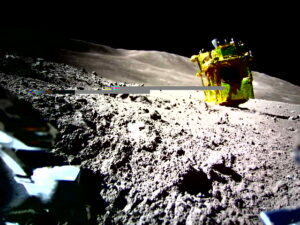Farewell SLIM
Japan’s space agency has ended attempts to reestablish communications with the Smart Lander for Investigating Moon or SLIM. Despite landing upside down in January, SLIM operated much longer than expected on the lunar surface. The final contact was on April 28.
Launched in September 2023, SLIM landed on the Moon on January 19, 2024 EST (January 20 in Japan). After losing an engine nozzle during descent, it landed upside-down, but functioning.

The solar arrays weren’t pointed in the right direction, however, and SLIM lost power and stopped transmitting. Contact was restored after the sun angle changed and the battery recharged.
Japan Aerospace Exploration Agency (JAXA) scientists and engineers were thrilled with the images and data SLIM sent back during that first lunar day. Like other small landers being sent to the Moon by several countries and companies these days, however, the lander’s electronics were not designed to survive the bitter cold 14-day lunar nights. Expectations were very low that it would be heard from again.
SLIM continued to beat the odds, though. Not only did it resume transmissions in February, but in March and April, too.
JAXA continued attempts to resume contact thereafter, but announced today they’ve ended.
[Press Release]
Conclusion of Lunar Activities of the Smart Lander for Investigating Moon (SLIM)#JAXAhttps://t.co/eO9xtP1zis— JAXA(Japan Aerospace Exploration Agency) (@JAXA_en) August 26, 2024
Returning data and imagery were key priorities, but JAXA’s top goal was demonstrating landing accuracy within 100 meters.
A detailed summary of the mission will be released later, but for now JAXA’s press release points out that not only did SLIM achieve a pinpoint landing within 10 meters of the target and collect multispectral data, but survived three lunar nights — “results that surpassed initial goals.”
“The landing precision was evaluated with a position error of approximately 10 meters from the target point, confirming the world’s first successful pinpoint landing. In addition, the Multi-Band Camera (MBC) successfully performed spectral observations in 10 wavelength bands on 10 rocks, exceeding initial expectations. Further, despite not being part of the original mission plan, the spacecraft was confirmed to survive three lunar nights and remained operational, demonstrating results that surpassed initial goals.” — JAXA
Before launch, JAXA issued a list of the project’s success criteria, all of which appear to have been met.

SLIM also delivered two tiny rovers, Lev1 and Lev2, that were ejected just before landing. Lev1 could communicate back to Earth directly. Lev2 was a baseball-size transformer that had a camera and communicated via Lev1. The photo of SLIM on the surface was taken by Lev2.

User Comments
SpacePolicyOnline.com has the right (but not the obligation) to monitor the comments and to remove any materials it deems inappropriate. We do not post comments that include links to other websites since we have no control over that content nor can we verify the security of such links.